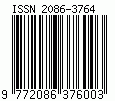Creative Kampong and the Promotion of Sustainable Development Knowledge in Urban Grassroots: The Case of Surakarta
DOI:
https://doi.org/10.26905/lw.v15i2.9891Keywords:
Sustainability, SMEs, Urban Development, Creative Kampong, Actor Network Theory (ANT)Abstract
As the global trend is going into circular economy paradigm. The trend encourages business entities to focus on the production of durable, efficient, and reusable commodities to promote sustainable development. On the demand side, the market also gradually adjusts its preferences to commodities with sustainability values. With limited scale of capital, networks, and technology, Small and Medium Enterprises (SMEs) are usually lagged behind in catching new knowledge, especially those exchanged internationally. Sustainability, which is as an important knowledge under the circular economy trend, has caused serious problem for SMEs because those unable to catch the knowledge will be incompetent to serve the new market preferences and vulnerable to survive. Urban planning practices introduce the business district as one of spatial concepts to mediate the problem. It encourages enterprises with business linkages to locate next to each other and share activities and facilities. In Indonesia, the creative kampong is a local translation of business district concept, which emerges as a national hype. This research aims at studying the empirical case of the creative kampong and its knowledge transfer effectiveness for SMEs. By using the logic of Actor Network Theory (ANT) and focusing on the case study of four creative kampongs in Surakarta, we unravel the level of understanding of SMEs towards sustainability. Our data are based on stakeholder interviews and documentary reviews. The findings reveal that the majority of SMEs were understand of sustainability, and the creative kampong provided a significant contribution to ease the transfer knowledge process.
Downloads
References
Astuti, W., Qomarun, Febela, A., Putri, R. A., & Astuti, D. W. (2016). Identification of Specific Characteristic of Kampung Jayengan as Community-based Industrial Tourism. Procedia - Social and Behavioral Sciences, 227, 485–492. http://linkinghub.elsevier.com/retrieve/pii/S1877042816307893
Bappeda Kota Surakarta. (2014). The Blueprint of Creative Economy Development Surakarta 2015-2025.
Binek, D., & Al-Muhannadi, K. (2020). Small and Medium-Sized Enterprises Within the Circular Economy: Challenges and Opportunities. Hungarian Agricultural Engineering, 37, 5–13. https://doi.org/10.17676/hae.2020.37.5
Campbell, S. (2016). Green Cities, Growing Cities, Just Cities?: Urban Planning and the Contradictions of Sustainable Development. In S. S.
Fainstein & J. DeFilippis (Eds.), Readings in Planning Theory. Blackwell Publishing.
Clusel, S., Guarnieri, F., Martin, C., & Lagarde, D. (2014). Assessing the vulnerability of SMEs: A qualitative analysis. Safety, Reliability and Risk Analysis: Beyond the Horizon - Proceedings of the European Safety and Reliability Conference, ESREL 2013, September 2013, 2703–2711.
Cooke, P., & Lazzeretti, L. (2008). Creative Cities, Cultural Clusters and Local Economic Development. Edward Elgar Publishing Limited.
Darchen, S., & Tremblay, D. G. (2015). Policies for Creative Clusters: A Comparison between the Video Game Industries in Melbourne and Montreal. European Planning Studies, 23(2), 311–331. https://doi.org/10.1080/09654313.2013.865712
de Leeuw, E., & Simos, J. (2017). Healthy Cities The Theory, Policy, and Practice of Value-Based Urban Planning. In Healthy Cities 2017. Springer. https://doi.org/10.1007/978-1-4939-6694-3
De Medeiros, J. F., Ribeiro, J. L. D., & Cortimiglia, M. N. (2014). Success factors for environmentally sustainable product innovation: A systematic literature review. Journal of Cleaner Production, 65, 76–86. https://doi.org/10.1016/j.jclepro.2013.08.035
Dinas Lingkungan Hidup Kota Surakarta. (2019). Masterplan Pengelolaan Limbah Kota Surakarta.
Douglass, M. (2015). Creative communities and the cultural economy — Insadong, chaebol urbanism and the local state in Seoul. Cities, 56, 148–155. https://doi.org/10.1016/j.cities.2015.09.007
Ellen MacArthur Foundation. (2013). Towards the circular economy. Journal of Industrial Ecology. 23–44.
Evans, G. (2009). Creative Cities, Creative Spaces and Urban Policy. In Urban Studies (Vol. 46, Issues 5–6). https://doi.org/10.1177/0042098009103853
Febela, A. (2015). Pengembangan industri batik ramah lingkungan: Studi kasus Kampoeng Batik Laweyan. Simposium Nasional RAPI XIV, 21–26.
Fernández-Viñé, M. B., Gómez-Navarro, T., & Capuz-Rizo, S. F. (2010). Eco-efficiency in the SMEs of Venezuela. Current status and future perspectives. Journal of Cleaner Production, 18(8), 736–746. https://doi.org/10.1016/j.jclepro.2009.12.005
Foxon, T., & Pearson, P. (2008). Overcoming barriers to innovation and diffusion of cleaner technologies: some features of a sustainable innovation policy regime. Journal of Cleaner Production, 16(1 SUPPL. 1), 148–161.
Guimarães, P. (2021). Business improvement districts: A systematic review of an urban governance model towards city center revitalization. Land, 10(9). https://doi.org/10.3390/land10090922
Hart, S. L., & Milstein, M. B. (2003). Creating sustainable value. Academy of Management Executive, 17(2), 56–69. https://doi.org/10.5465/ame.2003.10025194
Hartley, J. (2005). Creative Industries. Blackwell Publishing.
Henrysson, M., Papageorgiou, A., Björklund, A., Vanhuyse, F., & Sinha, R. (2022). Monitoring Progress Towards a Circular Economy in Urban Areas: An Application of the European Union Circular Economy Monitoring Framework in Umeå Municipality. SSRN Electronic Journal, 87(September). https://doi.org/10.2139/ssrn.4155257
Hospers, G. J., & Van Dalm, R. (2005). How to create a creative city? The viewpoints of Richard Florida and Jane Jacobs. Foresight, 7(4), 8–12. https://doi.org/10.1108/14636680510611796
Hudalah, D., Octifanny, Y., Talitha, T., Firman, T., & Phelps, N. A. (2020). From Metropolitanization to Megaregionalization: Intentionality in the Urban Restructuring of Java’s North Coast, Indonesia. Journal of Planning Education and Research. https://doi.org/10.1177/0739456X20967405
Kirchherr, J., Reike, D., & Hekkert, M. (2017). Conceptualizing the circular economy: An analysis of 114 definitions. Resources, Conservation and Recycling, 127(April), 221–232. https://doi.org/10.1016/j.resconrec.2017.09.005
Kong, L., & O’Connor, J. (2009). Creative Economies, Creative Cities: Asian-European Perspectives. Springer. https://doi.org/10.1007/978-1-4020-9949-6
Landry, C. (2000). The Creative City. Earthscan.
Landry, C., & Bianchini, F. (1995). The Creative City. Demos.
Magala, D. B., Najjingo Mangheni, M., & Miiro, R. F. (2019). Actor social networks as knowledge sharing mechanisms in multi-stakeholder processes: a case of coffee innovation platforms of Uganda. Journal of Agricultural Education and Extension, 25(4), 323–336. https://doi.org/10.1080/1389224X.2019.1629971
Marin, G., Marzucchi, A., & Zoboli, R. (2015). SMEs and barriers to Eco-innovation in the EU: Exploring different firm profiles. Journal of Evolutionary Economics, 25(3), 671–705. https://doi.org/10.1007/s00191-015-0407-7
McKeiver, C., & Gadenne, D. (2005). Environmental Management Systems in Small and Medium Businesses. International Small Business Journal, 23(5), 513–537. https://doi.org/10.1177/0266242605055910
Meerow, S., & Newell, J. P. (2019). Urban resilience for whom, what, when, where, and why? Urban Geography, 40(3), 309–329. https://doi.org/10.1080/02723638.2016.1206395
Millard, E. (2017). Still brewing: Fostering sustainable coffee production. World Development Perspectives, 7–8(November), 32–42. https://doi.org/10.1016/j.wdp.2017.11.004
Pappalepore, I., Maitland, R., & Smith, A. (2014). Prosuming creative urban areas. Evidence from East London. Annals of Tourism Research, 44(1), 227–240. https://doi.org/10.1016/j.annals.2013.11.001
Permana, C. (2019). Community Initiatives and The Reshaping of Collaborative Planning Practice in Indonesia: The Case of Creative Kampong (PhD Thesis). University of Liverpool.
Permana, C. T., & Harsanto, B. (2020). Sustainable City Planning Concepts and Practices in Emerging Economies : A Systematic Review. The Journal of Indonesia Sustainable Development Planning, I(1), 67–82.
Petit-Boix, A., & Leipold, S. (2018). Circular economy in cities: Reviewing how environmental research aligns with local practices. Journal of Cleaner Production, 195(July), 1270–1281. https://doi.org/10.1016/j.jclepro.2018.05.281
Pratt, A. C. (2009). Policy Transfer and the Field of the Cultural and Creative Industries: What Can Be Learned from Europe? In L. Kong &
J. O’Connor (Eds.), Creative Economies, Creative Cities: Asian-European Perspectives (pp. 9–24). Springer.
Remøy, H., Wandl, A., Ceric, D., & van Timmeren, A. (2019). Facilitating circular economy in urban planning. Urban Planning, 4(3), 1–4. https://doi.org/10.17645/up.v4i3.2484
Rydin, Yvone, & Tate, L. (2016). Actor Networks of Planning. Routledge.
Rydin, Yvonne. (2012). Using Actor – Network Theory to understand planning practice : Exploring relationships between actants in regulating low-carbon commercial development. https://doi.org/10.1177/1473095212455494
Sandee, H. (2002). SME clusters in Indonesia : An analysis of growth dynamics and employment conditions Report to the International
Labour Organization October 2002 (Vol. 2002, Issue October).
Sasaki, I., & Sone, H. (2015). Cultural Approach to Understanding the Long-term Survival of Firms – Japanese Shinise Firms in the Sake Brewing Industry. Business History, 57(7), 1020–1036. https://doi.org/10.1080/00076791.2014.993618
Sasaki, M. (2010). Urban Regeneration through Cultural Creativity and Social Inclusion: Rethinking Creative City Theory through a Japanese Case Study. Cities, 27(SUPPL. 1), S3–S9. https://doi.org/10.1016/j.cities.2010.03.002
Scott, A. J. (2016). Creative Cities : Conceptual Issues and Policy Questions. Journal of Urban Affairs, 2166(1), 1–17. https://doi.org/10.1111/j.0735-2166.2006.00256.x
Tschang, T. (2009). Creative Industries Across Cultural Borders: The Case of Video Games in Asia. In L. Kong & J. O’Connor (Eds.), Creative Economies, Creative Cities: Asian-European Perspectives (pp. 25–43). Springer.
van Meerkerk, I., Boonstra, B., & Edelenbos, J. (2013). Self-Organization in Urban Regeneration: A Two-Case Comparative Research. European Planning Studies, 21(10), 1630–1652. https://doi.org/10.1080/09654313.2012.722963
Vanhuyse, F., Fejzić, E., Ddiba, D., & Henrysson, M. (2021). The lack of social impact considerations in transitioning towards urban circular economies: a scoping review. Sustainable Cities and Society, 75. https://doi.org/10.1016/j.scs.2021.103394
Wattanacharoensil, W., & Sakdiyakorn, M. (2016). The Potential of Floating Markets for Creative Tourism: A Study in Nakhon Pathom Province, Thailand. Asia Pacific Journal of Tourism Research, 21, S3–S29. https://doi.org/10.1080/10941665.2014.998250
Yum, S. (2019). The relationship between creative industries and the urban economy in the USA. Creative Industries Journal, 0(0), 1–22. https://doi.org/10.1080/17510694.2019.1668741












